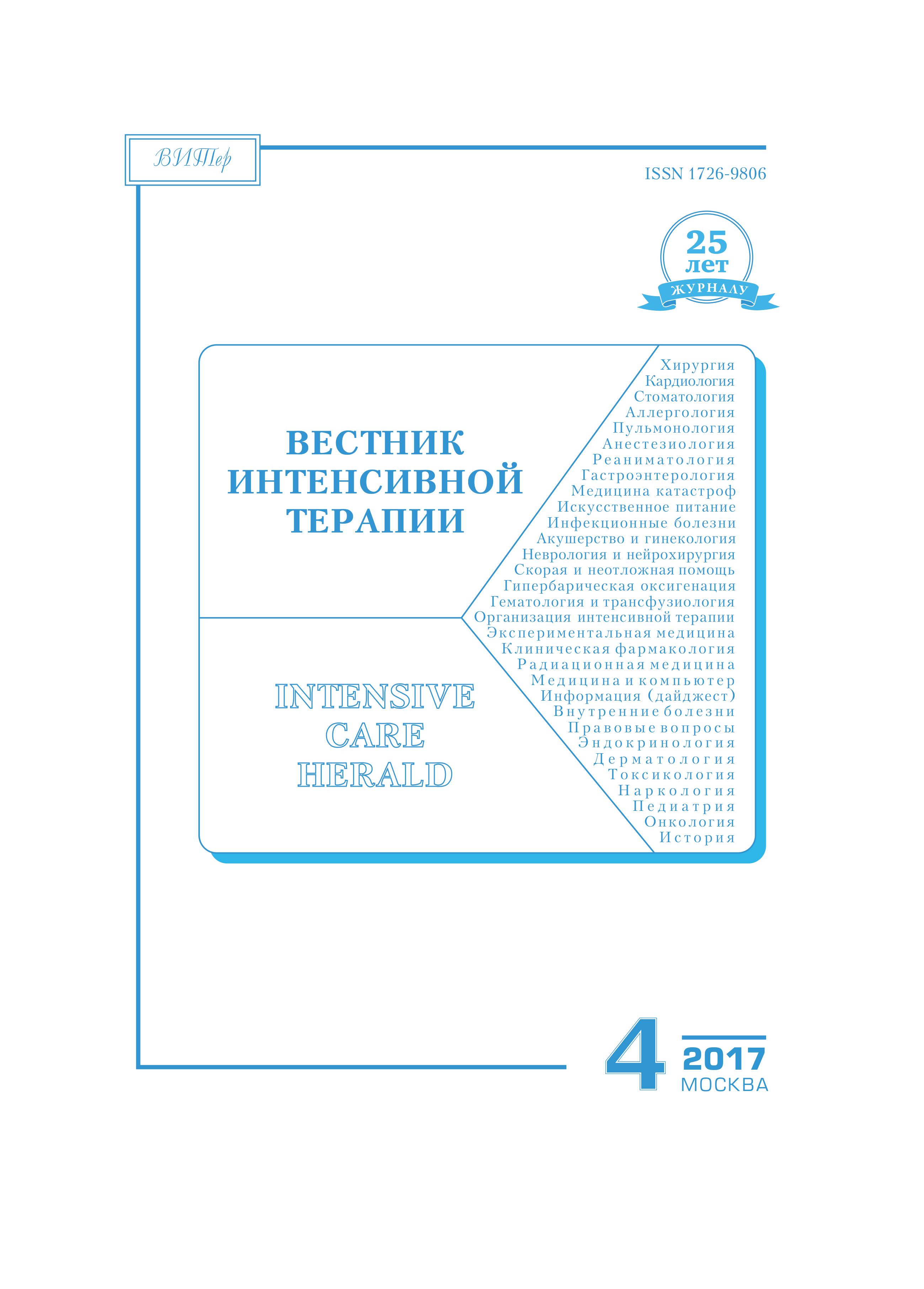Аннотация
Введение. Выполнение каротидной эндартерэктомии под регионарной анестезией с седацией позволяет осуществлять динамический неврологический мониторинг. Основным недостатком такого подхода считается дискомфорт пациента. В связи с этим необходимость в проведении качественной седации при операции КЭА в условиях регионарной анестезии очевидна. Особый интерес вызывает использование дексмедетомидина, обладающего уникальным действием на ЦНС, как базового препарата для интраоперационной седации. Материал и методы. 112 пациентов рандомизированы на две группы. Группу № 1 (группа пропофола) составили 53 человека, в группу № 2 (группа дексмедетомидина) вошли 59 человек. Различия между группами отсутствовали (p = 0,36). В группе № 1 после выполнения регионарной анестезии начинали инфузию пропофола по целевой концентрации до целевого уровня в плазме 1,7 мг/мл. Пациенты из группы № 2 начинали получать дексмедетомидин со скорости 0,2 мкг/кг/час с увеличением скорости инфузии до 0,9–1 мкг/кг/час к окончанию выполнения регионарной анестезии. Удовлетворенность пациентов анестезиологическим пособием оценивали по результатам ответов на вопросы анкеты-опросника на следующий день после оперативного вмешательства. Результаты. В диапазон 13–15 баллов («удовлетворенные пособием») попало почти две трети пациентов группы № 2 — 38 человек (64,40 %), в то время как в группе № 1 в этот диапазон попало только 11 (20,75 %) пациентов (p < 0,0001). В промежуток 10–12 баллов («практически удовлетворенные») вошло 37 (69,81 %) пациентов группы № 1 и 19 (32,20 %) пациентов группы № 2 (p = 0,0001). Менее 10 баллов («неудовлетворенные») набрало 5 (9,43 %) пациентов в группе № 1 и 2 (3,38 %) пациента в группе № 2, различия между группами оказались недостоверными (p = 0,3). Следует также отметить, что все пациенты, оценившие свое пребывание в операционной как некомфортное (3 человека), имели в итоге и низкую сумму баллов (< 10), что говорит об определенной степени чувствительности предложенной анкеты. Выводы. Несмотря на то, что пациенты, получавшие в качестве седативного агента дексмедетомидин, хоть и имели более поверхностную седацию и отметили больше воспоминаний об этапе ДНМ, в целом показали сравнимую с группой, получавшей пропофол, общую удовлетворенность пособием. Более того, пациентов, полностью удовлетворенных пособием, в группе дексмедетомидина оказалось достоверно больше.
Библиографические ссылки
- Куликов А.С., Шмигельский А.В., Лубнин А.Ю. Седация дексмедетомидином при проведении каротидной эндартерэктомии в сознании. Регионарная анестезия и лечение острой боли. Т. 2013; 4: 30–34. [Kulikov A.S., Shmigel’skiy A.V., Lubnin A.Yu. Dexmedetomidine sedation for awake carotid endarterectomy. Vol. VII. 2013; 4: 30–34. (In Russ)]
- Licker M. Regional or general anaesthesia for carotid endarter Does it matter? European Journal of Anaesthesiology. 2016; 33: 241–243. doi: 10.1097/EJA.0000000000000376.
- Stoneham M.D., Stamou D., Mason J. Regional anaesthesia for carotid British Journal of Anaesthesia. 2015; 114(3): 372–383. doi: 10.1093/bja/aeu304.
- Wilke H.J., Ellis J.E., McKinsey J.F. Carotid endarterectomy: intraoperative anaesthesia and Journal Cardiothoracic Vascular Anaesthesia. 1996; 10: 928–949. doi: 10.1016/ s1053-0770(96)80060-7.
- Quigley T.M., Ryan W.R., Morgan S. Patient satisfaction after carotid endarterectomy using a selective policy of local anaesthesia. American Journal of Surgery. 2000; 179(5): 382–385. doi: 1016/s0002-9610(00)00371-8.
- McCarthy J., Trigg R., John C., Gough M.J., Horrocks M. Patient satisfaction for carotid endarterectomy performed under local anaesthesia. European Journal Vascular Endovascular Surgery. 2004; 27(6): 654–659. doi: 10.1016/j.ejvs.2004.03.010.
- Attigah N., Kutter J., Demirel S., Hakimi M., Hinz U. et al. Assessment of patients satisfaction in carotid surgery under local anaesthesia by psychometrical testing. A prospective cohort study. European Journal Vascular Endovascular Surgery. 2011; 41(1): 76–82. doi: 1016/j.ejvs.2010.08.020.
- Marcucci G., Siani A., Accrocca F., Gabrielli R., Giorda- no A. et al. Preserved consciousness in general anesthesia during carotid endarterectomy: a six-year experience. Interactive Cardiovascular Thoracic Surgery Journal [Internet]. 2011; 13(6): 601–605. doi: 1510/icvts.2011.280321.
- Martin E., Ramsay G., Mantz J., Sum-Ping S.T. The role of the a2-adrenoceptor agonist dexmedetomidine in postsurgical sedation in the intensive care unit. Journal Intensive Care Med. 2003; 18: 29–41. doi: 1177/0885066602239122.
- Venn R.M., Grounds R.N. Comparison between dexmedetomidine and propofol for sedation in the intensive care unit: Patient and clinician perceptions. British Journal of Anesthesia. 2001; 87: 684–690. doi: 1093/bja/87.5.684.
- Ebert T.J., Hall J.E., Barney J.A., Uhrich T.D., Colinco M.D. The effects of increasing plasma concentrations of dexmedetomidine in humans. Anesthesiology. 2000; 93: 382–394. doi: 1097/00000542-200008000-00016.
- Hall J.E., Uhrich T.D., Barney J.A., Arain S.R., Ebert T.J. Sedative, amnestic, and analgesic properties of small-dose dexmedetomidine Anesthesia Analgesia. 2000; 90: 699–705. doi: 10.1097/00000539-200003000-00035.
- Ji F., Li Z., Nguyen H., Young N., Shi P., Fleming N. et al. Perioperative dexmedetomidine improves outcomes of cardiac surgery. 2013; 128: e339–e340. doi: 10.1161/CIR- CULATIONAHA.113.005450.
- Benggon M., Chen H., Applegate R., Martin R., Zhang J.H. Effect of dexmedetomidine on brain edema and neurological outcomes in surgical brain injury in rats. Anesthesia Analgesia. 2012; 115: 154–159. doi: 1213/ANE.0b013e31824e2b86.
- Zhu Y.M., Wang C.C., Chen L., Qian L.B., Ma L.L .et a Both PI3K/Akt and ERK1/2 pathways participate in the protection by dexmedetomidine against transient focal cerebral ischemia/reperfusion injury in rats. Brain. Res. 2013; 1494: 1–8. doi: 10.1016/j.brainres.2012.11.047.

Это произведение доступно по лицензии Creative Commons «Attribution-NonCommercial-ShareAlike» («Атрибуция — Некоммерческое использование — На тех же условиях») 4.0 Всемирная.
Copyright (c) 2017 ВЕСТНИК ИНТЕНСИВНОЙ ТЕРАПИИ имени А.И. САЛТАНОВА

